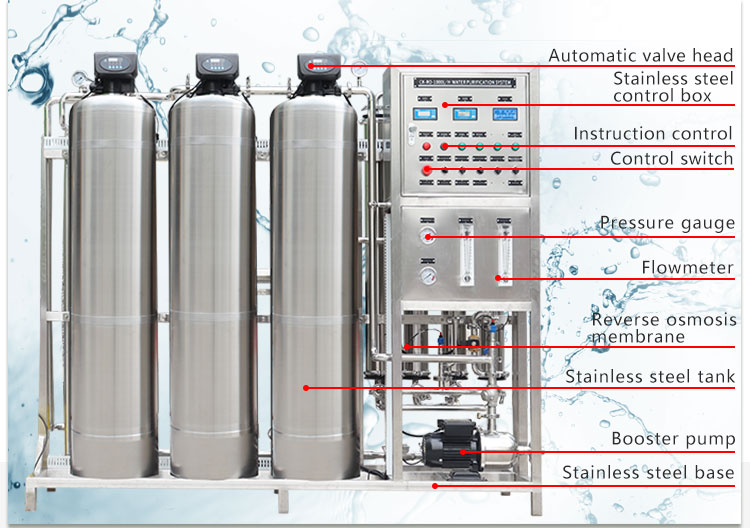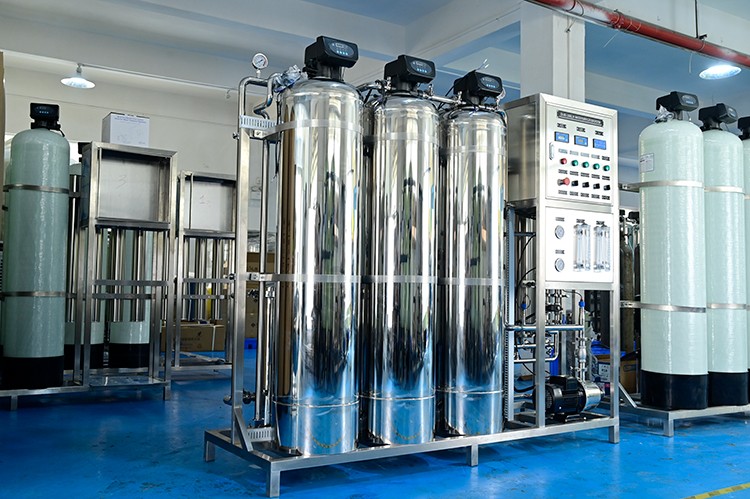Is reverse osmosis water suitable for ice makers?
The quality of ice cubes produced by ice makers directly affects the taste of drinks and food, and even affects the health of consumers. Therefore, choosing a suitable water source is crucial for ice makers. Reverse osmosis (RO) water is widely regarded as a high-quality drinking water source due to its high purity. So, is reverse osmosis water suitable for making ice cubes? This article will explore this issue from multiple angles.

Basic characteristics of reverse osmosis water
1.1 Reverse osmosis water production process
Reverse osmosis water is pure water obtained by pressurizing raw water through a semipermeable membrane through a reverse osmosis system to remove dissolved salts, organic matter, microorganisms and other impurities in the water. Its main characteristics include:
● Low dissolved salt content: The reverse osmosis membrane can remove more than 99% of dissolved salts, making the conductivity of the produced water extremely low.
● Very few inorganic pollutants: Effectively remove heavy metals, nitrates and other inorganic pollutants.
● High microbial and organic matter removal rate: Reverse osmosis water contains almost no bacteria, viruses and organic matter.
1.2 Advantages of reverse osmosis water
Reverse osmosis water has the following advantages due to its high purity:
● Pure taste: no odor, no impurities.
● Safe and healthy: most harmful substances are removed.
● Suitable for sensitive people: suitable for infants, the elderly and people with weak immunity.
Application of reverse osmosis water in ice makers
2.1 Working principle of ice makers
Ice makers inject water into the evaporator and cool it to form ice cubes. The performance of the ice maker and the quality of the ice cubes are closely related to the quality of the water source. Common types of ice makers include:
● Direct cooling ice maker: ice cubes are formed by directly cooling water, suitable for small and household ice makers.
● Water-cooled ice maker: uses cooling water circulation to cool the inside of the ice maker, suitable for large commercial ice makers.
● Air-cooled ice maker: cooled by air, suitable for small and medium-sized commercial ice makers.
2.2 The impact of reverse osmosis water on ice makers
The use of reverse osmosis water to make ice cubes has the following significant effects:
● Ice transparency: Since reverse osmosis water contains very little dissolved salt and impurities, the ice cubes made are usually more transparent and crystal clear.
● Ice hardness and taste: Ice cubes made with pure water have moderate hardness and melt slowly, which helps to maintain the taste of drinks.
● Equipment maintenance: The mineral content in reverse osmosis water is extremely low, which can effectively reduce scale deposition inside the ice maker and reduce maintenance frequency and cost.
● Hygiene and safety: The bacteria and organic matter content in reverse osmosis water is extremely low, which helps to ensure the hygiene and safety of ice cubes, and is particularly suitable for the catering industry and medical field.

Challenges of reverse osmosis water in ice making applications
Although reverse osmosis water has excellent performance in many aspects, there are also some challenges in ice making applications:
3.1 Cost issues
The initial installation cost of the reverse osmosis system is high, including equipment purchase, installation and commissioning. In addition, the system consumes electricity and water resources during operation, which increases the cost of using reverse osmosis water in the ice maker.
3.2 Wastewater Discharge
The reverse osmosis system produces wastewater during the water production process, and the recovery rate is usually 50% to 75%, which means that 0.3 to 1 liter of wastewater is generated for every liter of reverse osmosis water produced. The treatment and discharge of wastewater requires additional management and expenses.
3.3 Necessary Maintenance
The reverse osmosis system requires regular maintenance and replacement of filter elements and membrane elements to ensure the quality of water production and the normal operation of the system. These maintenance tasks require expertise and additional costs.

How to optimize the use of reverse osmosis water in ice makers
In order to maximize the advantages of reverse osmosis water in ice makers and solve the challenges in its use, the following are some optimization suggestions:
4.1 Comprehensive evaluation and selection
Before deciding to use reverse osmosis water, its cost, wastewater treatment and maintenance requirements should be comprehensively evaluated. According to the frequency of use of the ice maker, ice quality requirements and budget, select a suitable reverse osmosis system.
4.2 Use pretreatment equipment in conjunction with
Installing appropriate pretreatment equipment such as water softeners and activated carbon filters before the reverse osmosis system can effectively extend the life of the reverse osmosis membrane and reduce maintenance frequency and costs.
4.3 Optimize wastewater utilization
The wastewater generated by the reverse osmosis system can be used for other non-drinking water needs, such as cleaning, irrigation, etc., so as to improve the utilization rate of water resources and reduce the cost of wastewater treatment.
4.4 Regular maintenance and monitoring
Develop a detailed maintenance plan, regularly replace the filter element and membrane element to ensure the efficient operation of the reverse osmosis system. At the same time, monitor the water quality parameters of the reverse osmosis water and adjust the system operation parameters in time.
Conclusion
Due to its high purity and excellent water quality characteristics, reverse osmosis water is suitable as a water source for ice makers. Ice cubes made with reverse osmosis water are transparent and pure, which can improve the taste and quality of drinks and reduce the maintenance cost of equipment.
However, its high initial investment and operating costs require users to conduct comprehensive evaluation and optimize use.






